Programs for Funding and Technical Assistance
Let’s Get Started …
There are a variety of federal, state, and non-profit partner led programs that provide up to 100% of the costs and offer technical assistance.
Consortium partners can help you with riparian buffers on your property by listening to your needs and vision, connecting you to cost and technical assistance programs, and ensuring your investments in healthy land and water last for the next generation. This can include Excluding Cattle, Planting a New Buffer, Maintaining Your Buffer, and/or Protecting/Conserving Your Buffer. Riparian buffers are the trees, shrubs, and other vegetation along our waterways. These streamside forests provide the James River and its tributaries with the protection they need.
Find a program that works for you!
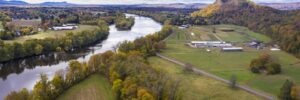
Agricultural Land Easements (ALE)
Agricultural Land Easements (ALE), a component of the Agricultural Conservation Easement Program (ACEP), help farmers and ranchers keep their land in agriculture. ALE protects the long-term viability of the nation’s food supply by preventing conversion of productive working lands to non-agricultural uses. Landowners receive compensation and retain private ownership of their land, but must follow certain land use requirements.
KEYWORDS: Protect/Conserve
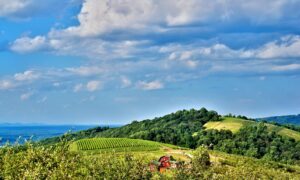
Albemarle Conservation Easement Authority (ACEA)
The Albemarle Conservation Easement Authority (ACEA) is a public body established by the Board of Supervisors and holds easements that protect rural land from development and that preserve important natural and cultural resources across the County. ACEA holds three different types of easements — donated open-space easements, ACE program easements (which it co-holds with the County), and easements over the preservation tracts of Rural Preservation Developments (RPDs).
The Albemarle Conservation Easement Authority, which is appointed by the Board of Supervisors, is one of several easement holders that accept conservation easements on land in the County.
KEYWORDS: Protect/Conserve
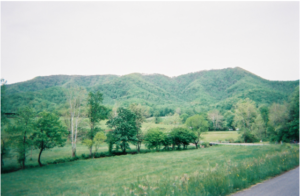
Blue Ridge Land Conservancy Easements
Blue Ridge Land Conservancy is a community-based, non-profit organization that helps protect local lands important to the quality of life and environmental health of the Blue Ridge region.
Hundreds of families in southwest Virginia have chosen to make sure their land stays in its rural or natural state forever through conservation easements: voluntary, permanent agreements between landowners and land trusts like the Blue Ridge Land Conservancy that describe how the land can be used in the future.
Learn more about easements and your landowner rights in our Conservation Guide for Virginia Landowners.
KEYWORDS: Protect/Conserve
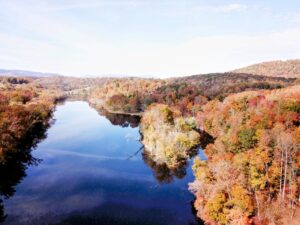
Central Virginia Land Conservancy Easements
Central Virginia Land Conservancy (CVaLC) is a small, non-profit organization that helps landowners conserve their property through voluntary land preservation agreements known as conservation easements. These are voluntary, permanent agreements between landowners and land trusts like the Central Virginia Ridge Land Conservancy that describe how the land can be used in the future. CVaLC has worked with farmers and other landowners in preserving thousands of acres in our service area.
In 2019, the Central Virginia Land Conservancy merged with the Roanoke-based Blue Ridge Land Conservancy to form a larger organization with more resources and save more land across 16 Virginia counties. Learn more about easements and your landowner rights in this Conservation Guide for Virginia Landowners prepared by the Blue Ridge Land Conservancy.
KEYWORDS: Protect/Conserve
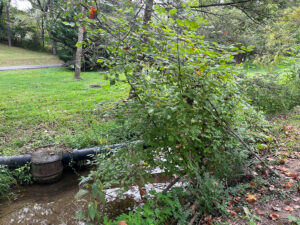
Conservation Reserve Enhancement Program (CREP)
CREP pays farmers an annual rental rate in exchange for removing environmentally sensitive land from production and establishing permanent resource conserving plant species, often in the form of riparian buffers. CREP farmers agree to maintain buffers, but maintain their property rights. In addition to the rental payments, farmers will be reimbursed for approved costs. Additional incentives may be specified in each agreement.
KEYWORDS: Plant new buffer • other conservation projects
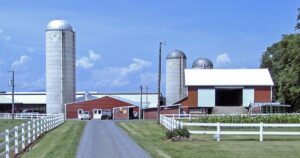
Conservation Stewardship Program (CSP)
The Conservation Stewardship Program (CSP) is designed to compensate agricultural and forest producers who agree to increase their level of conservation by adopting additional conservation activities and maintaining their baseline level of conservation. CSP is for producers who are passionate about conservation and environmental stewardship.
CSP offers annual payments for implementing approved conservation activities through five year contracts.
KEYWORDS: Plant new buffer • other conservation projects
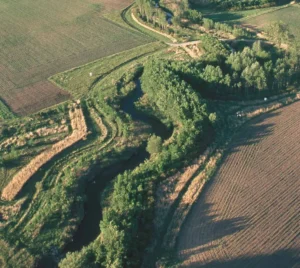
Continuous Conservation Reserve Program (Continuous CRP)
Conservation Reserve Program (CRP) focuses on reestablishing valuable land cover to help improve water quality, prevent soil erosion, and reduce loss of wildlife habitat. In exchange for a yearly rental payment, farmers and ranchers enrolled in CRP agree to remove environmentally sensitive land from agricultural production and plant species that will improve environmental health and quality. Participants may be eligible for sign-up incentive and up to 50% reimbursement for installation costs.
Continuous CRP is available on an ongoing basis and prioritizes enrollment of highly sensitive land to meet specific conservation goals, including buffer installation.
KEYWORDS: Plant new buffer • other conservation projects
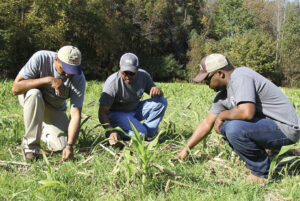
Environmental Quality Incentives Program (EQIP)
The Environmental Quality Incentives Program (EQIP) provides technical and financial assistance to agricultural producers and forest landowners to address natural resource concerns via the implementation of conservation practices. Producers are reimbursed after a conservation practice is certified as meeting NRCS standards and specifications. Advanced payments may be available for historically underserved producers.
KEYWORDS: Plant new buffer • exclude cattle • other conservation projects
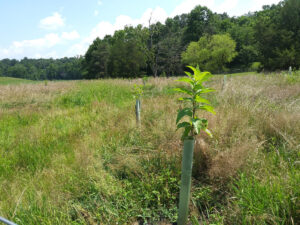
James River Buffer Program (JRBP)
The James River Buffer Program, administered by the James River Association and the Chesapeake Bay Foundation, works with property owners to restore riparian forest buffers that improve the quality of local waterways.
To be eligible, the project must be entirely within the Middle and Upper James watershed and have an area along a waterway on their property where a forested buffer of 35’ or more can be established. Thanks to funding from the Virginia Environmental Endowment and Virginia Department of Forestry, this program covers 100% of the project costs including design, site preparation as needed, materials, installation, and three years of establishment maintenance.
KEYWORDS: Plant new buffer
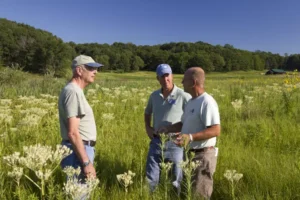
Partners for Fish and Wildlife Program
The Partners for Fish and Wildlife Program of the U.S. Fish and Wildlife Service provides technical and financial assistance to landowners interested in restoring and enhancing wildlife habitat on their land. Projects are custom-designed to meet landowners’ needs. Participating landowners continue to own and manage their land while they improve conditions for wildlife. All private landowners interested in restoring wildlife habitat on their land are eligible to participate. Current partners include farmers, ranchers, forest landowners, recreational landowners, corporations, local governments and universities.
KEYWORDS: Plant new buffer • maintain buffer • cattle exclusion • other conservation projects
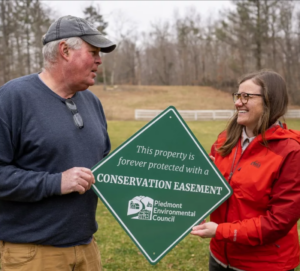
Piedmont Environmental Council Easements
Piedmont Environmental Council (PEC) is a private nonprofit land trust supporting conservation and restoration in the Virginia Piedmont. Landowners can choose to work with PEC to permanently protect their land from development through the gift of a conservation easement. An easement will protect the land you love forever, preserving farmland, forestland, wildlife habitat, streams, open space, and scenic vistas. Easement terms are netogiated between landowner and PEC, and financial assistance may be available. PEC staff can guide landowners through the easement process, information on tax incentives, and if PEC is the right easement holder for them.
KEYWORDS: Protect/Conserve
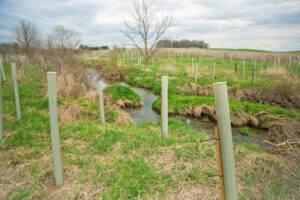
Riparian Forests for Landowners (RFFL)
The DOF Riparian Forests for Landowners (RFFL) program provides flexible, no-cost riparian forest buffer installation and one year of maintenance to landowners. The program is being implemented by DOF and partner organizations in a unique watershed-based partnership. Funding is provided by the Inflation Reduction Act through the USDA Forest Service and the Commonwealth of Virginia’s Water Quality Improvement Fund Act.
This program is open to private property owners including property/homeowner’s associations or civic leagues in rural, urban or suburban areas. Buffer can be installed on open land adjacent to a water feature where a forested buffer of at least 35 feet in width from the water’s edge can be planted. An existing buffer may be expanded up to 300 feet from the water’s edge.
KEYWORDS: Plant new buffer
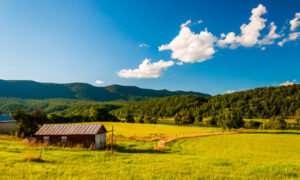
Shenandoah Valley Conservancy Easements
Shenandoah Valley Conservancy is the only land trust working exclusively to protect the Shenandoah Valley. For more than 30 years, Shenandoah Valley Conservancy has worked with landowners up and down the Valley to promote land conservation using conservation easements. Tens of thousands of acres of valuable farmland and forestland and hundreds of miles of streams and rivers are now permanently protected as a result. Shenandoah Valley Conservancy is committed to making the process of protecting your land forever as straightforward as possible.
Download the Shenandoah Valley Conservancy Landowners’ Guide to Conservation Easements or contact our team for more information.
KEYWORDS: Protect/Conserve
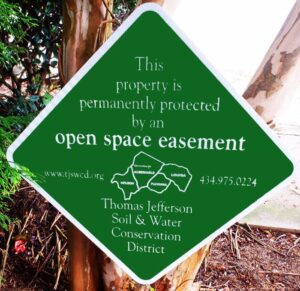
TJSWCD Open Space Easements
The Thomas Jefferson Soil and Water Conservation District (TJSWCD) is unique in that it focuses on preserving small properties (or portions of properties) associated with the protection of water resources. All TJSWCD Easements must protect water resources and typically include an entire parcel or farm, or may just protect the water resources on a property.
An easement can permanently protect open space on your property that you value, such as farmland, forest or streams, from future development. There may be certain tax or financial advantages of placing land under easement. The conveyance of an easement may be used to address federal, state, or local requirements intended to protect water quality following development of land. The developer or owner offers to permanently protect open space in lieu of more expensive stormwater alternatives.
KEYWORDS: Protect/Conserve
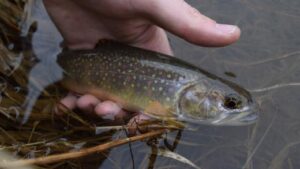
Upper James Home River Initiative
The Upper James River Home Initiative administered by Trout Unlimited targets the James River headwaters in Highland and Bath Counties. They assist landowners with conservation projects such as restoring streams, stabilizing streambanks, restoring riparian buffers, implementing conservation plans for local farmers, and installing livestock inclusion fencing. Trout Unlimited modeled the Initiative after a highly successful program in West Virginia.
KEYWORDS: Plant new buffer • cattle exclusion • other conservation projects

VDOF Riparian Forest Buffer Tax Credit Program
The Riparian Forest Buffer Tax Credit Program is designed to provide tax credits for landowners who retain riparian forest buffers while harvesting timber. The amount of the credit is equal to 25% of the value of the timber retained as a buffer up to a maximum of $17,500 in the tax year in which the harvesting operation is completed.
The tract must be at least 10 acres in size (including buffer), and the buffer must at least 35 feet wide and no greater than 300 feet.
KEYWORDS: Maintain buffer

Virginia Agricutural Cost-Share Program (VACS)
The VACS program offers financial incentives for farmers to adopt best management practices (BMPs) aimed at reducing nutrient pollution, sediment, and waste from entering waterways. Cost-share payments vary by practice, from 50 percent up to the full cost of implementation, and there is a maximum payment of $300,000 per year.
KEYWORDS: Plant new buffer • maintain buffer • cattle exclusion • other conservation projects
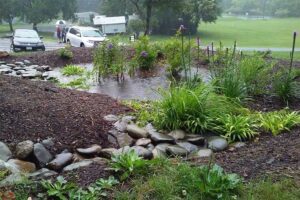
Virginia Conservation Assistance Program (VCAP)
The Virginia Conservation Assistance Program (VCAP) is an urban cost-share program that provides financial incentives and technical and educational assistance to property owners installing eligible Best Management Practices (BMPs) in Virginia’s participating Soil and Water Conservation Districts (SWCDs).
These practices can be installed in areas of your yard to fix three key issues: erosion, poor drainage, and/or poor vegetation occur. Most practices are eligible for 80% cost-share and some practices provide a flat incentive payment up to the installation cost-share and some practices provide a flat incentive payment up to the installation cost. Landowner is reimbursed for associated costs.
KEYWORDS: Plant new buffer • cattle exclusion • other conservation projects
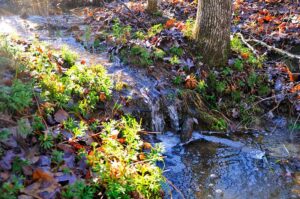
VOF Open Space Easements
Virginia Outdoors Foundation (VOF) is a resource for open-space easements – legal agreements between landowners and a public body, such as VOF that limit development rights while allowing landowners to continue living on and managing the land for farming, forestry, recreational, wildlife habitat, and other compatible uses.
Easement restrictions are embodied in a deed that is permanently bound to the property and passed down to future owners, helping with estate planning and potential tax benefits.The restrictions depends on the types of conservation values being protected, such as water quality, wildlife habitat. historic significance, scenic viewsheds, or public access.
KEYWORDS: Protect/Conserve

Wetland Reserve Easements (WRE)
Wetland Reserve Conservation Easements (WRE), a component of the Agricultural Conservation Easement Program, help landowners restore, protect, and enhance wetlands.
NRCS and the landowner work together to develop and implement a wetland reserve plan to guide the restoration easement process. Landowners receive compensation and retain private ownership of their land, but must follow certain land use requirements.
KEYWORDS: Protect/Conserve
Want to report a change to a program you see listed, or have a program to add?
Email Consortium Coordinator, Rachel Bensink, at rbensink@thejamesriver.com
